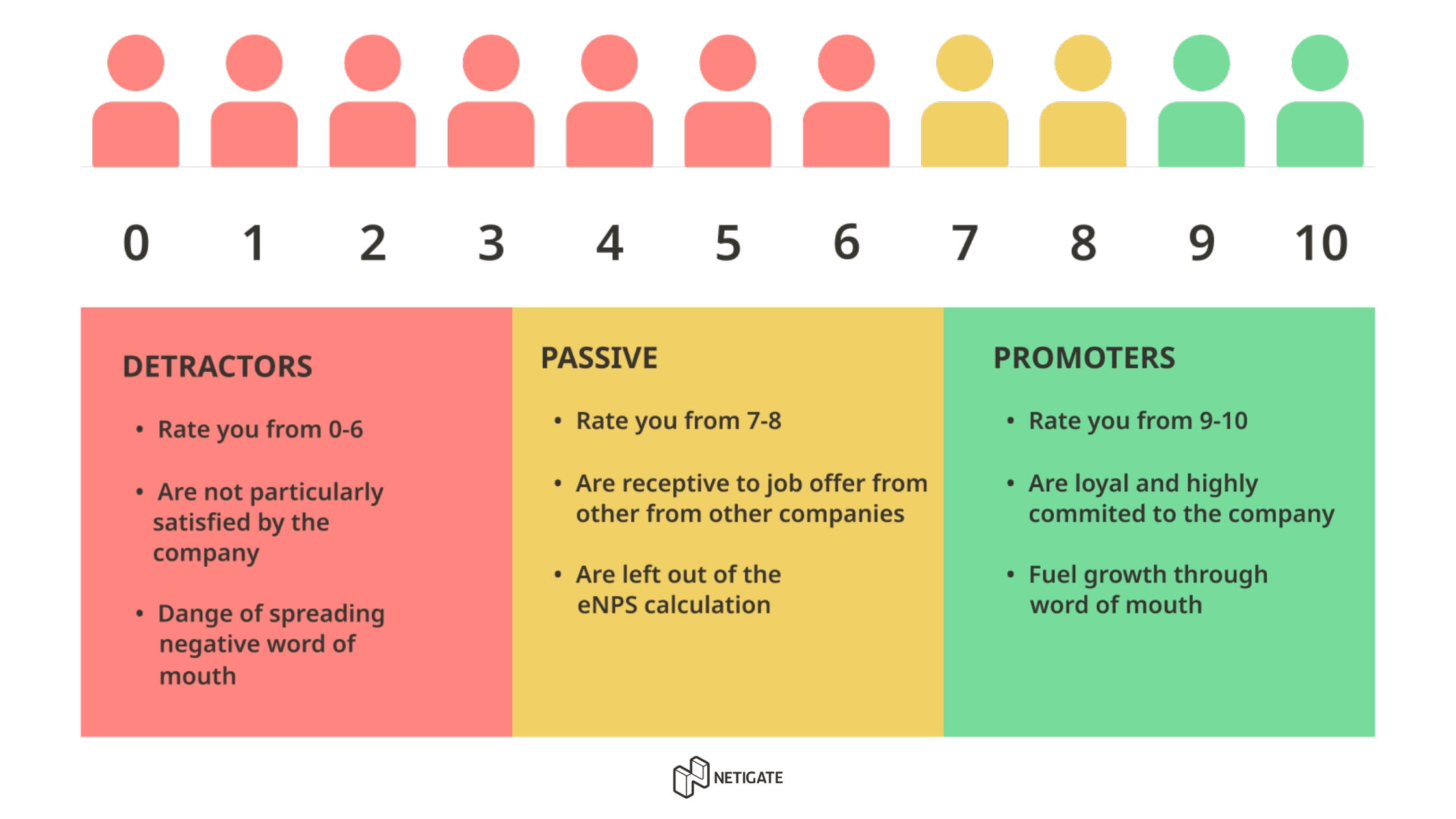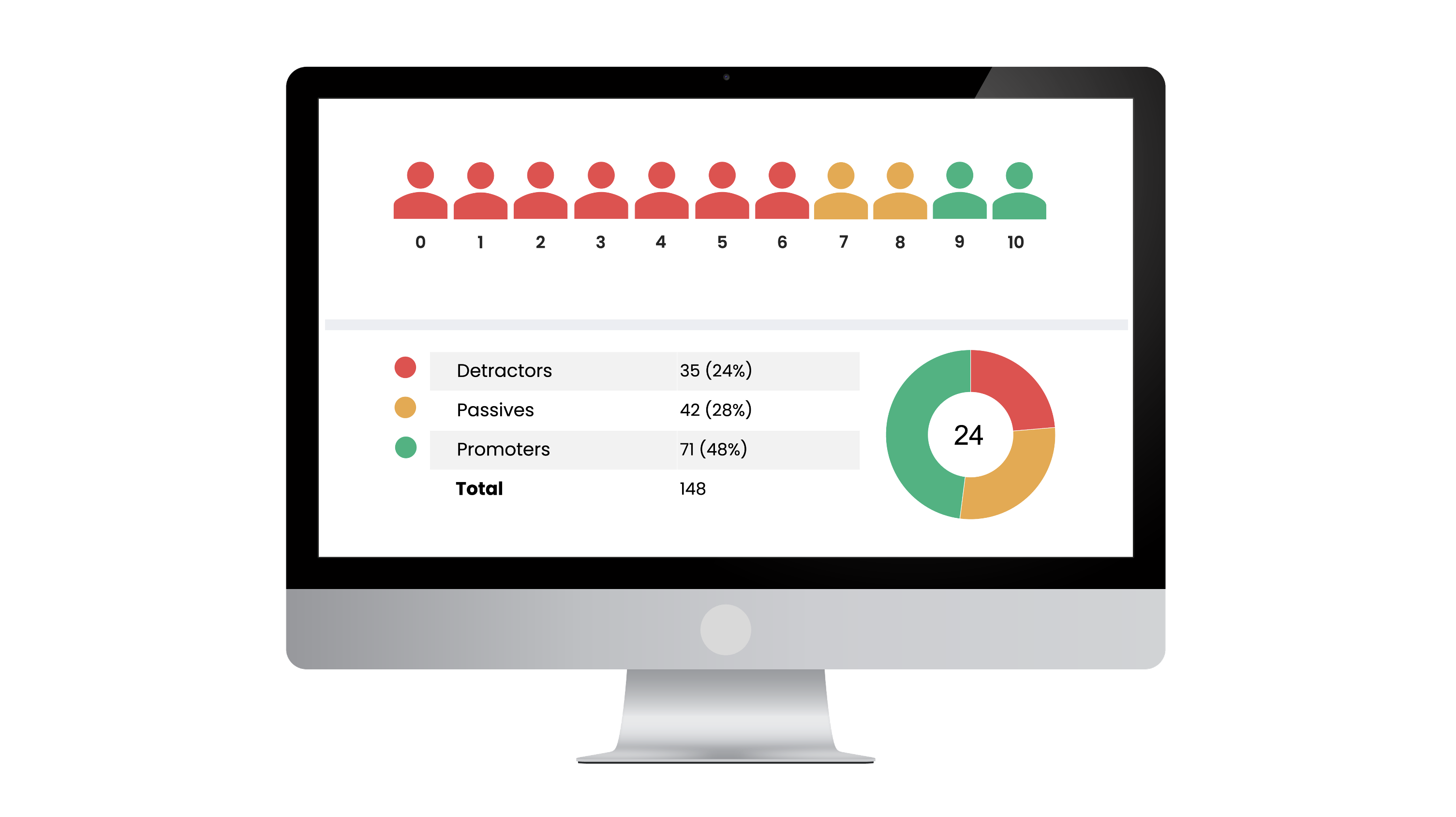The Net Promoter Score (NPS) is one of the most popular measurements for assessing customer loyalty and satisfaction. It provides a snapshot of customer sentiments, guiding improvements in customer satisfaction. You can use NPS to determine the likelihood of retaining your customers and the potential for extending your brand’s reach through positive recommendations. Among various approaches to understanding your customers’ opinions and experience, the NPS simplifies it with one straightforward question.
What is the NPS survey?
What exactly is NPS and what is a good NPS score?
The Net Promoter Score, short NPS, is a way to measure customer loyalty It was the American author Fred Reichheld who created the concept, which he presented in his book The Ultimate Question (2006), and the score has since become increasingly popular. Reichheld had been researching how one can measure customer satisfaction and customer retention and their relation to how successful and profitable a company is and can be. It is now widely used as a metric and an indicator of the growth of a company. Companies all over the world can check the status of their customer relationships and loyalty and learn how to make improvements.
At the core, the NPS boils down to one simple question:
“How likely is it that you would recommend this company (and/or product, and/or service) to a friend and/or a colleague?”
The whole concept of NPS is based on this one, simple question. Of course, there are necessary specifications (depending on whether you are asking about the company as a whole or specific parts / products / services). However, the ending will always point to the likelihood of a recommendation. You can adapt your starting point to your question individually. Think of different beginnings, such as:
- “Considering your experience with the company/service/product…”
- “From what you have experienced…”
- “Based on the products/services that you have bought and tried…”
- One can also completely skip the first introduction part of the question and get right to the point – “How likely is it that you would recommend us?”
Tip: We recommend to include a follow-up question after the NPS question to get deeper insights into why the customer answered the way they did. Using the Netigate Word Cloud, for instance, will also help you to sort all open-text answers and locate commonly used phrases.
What is a good NPS score?
The likelihood of recommendation is measured numerically from 0-10. Depending on their answers, you then sort respondents into three camps:

Promoters: Respondents who vote 9 or 10 to indicate that they are very likely to actively recommend you and are probably already doing so.
These are your aces! Promoters are loyal customers who have been consistently satisfied with your services and are happy to share their views, thus actively promoting your business.
Passives: Respondents who vote 7 or 8 are referred to as Passives.
They are satisfied with your products and services, however, would not go to active lengths to recommend you. They might be consistent customers but they are not necessarily committed or loyal. Bear in mind that customers might also be along different milestones of the customer journey. It helps to find out what you can offer to turn Passives into Promoters.
Detractors: Respondents who vote anything from 0 to 6 are called Detractors.
They might be unhappy customers or they might just be satisfied enough to have no complaints but wouldn’t actively recommend you. While it might seem disheartening to get those scores, they are the most useful insights into how you can improve customer satisfaction, loyalty, and thus your overall reputation and reach. You would want to reduce the number of Detractors as they might be the reason for negative word of mouth.
How do I calculate my Net Promoter Score?
By subtracting the % of Detractors from the % of Promoters you will get a number from -100 to 100 and this is your NPS. If you would have an extreme situation where all of your customers are Detractors then the score would be -100. If all of your customers instead would be Promoters the score would be 100. These extreme numbers are rarely (as in almost never) found but provide examples of how to understand how the NPS Calculator works.
With this calculation and the score, you can get a good measurement on how your customers, in general, perceive your brand. All positive numbers are good. So everything from 1 and up to 100 is by most people seen as a sign that you have happy customers. Achieving a score between 50 and 100 is not merely good; it is often regarded as exceptionally positive, implying a high level of customer satisfaction and loyalty. Once you have your score, it is beneficial to break it down into percentages of promoters, passives, and detractors. Looking at the results individually may offer unique insights into customer loyalty and satisfaction, allowing for informed decisions to enhance your brand’s overall experience.
It is important to note that different markets have different NPS benchmarks. Before drawing too many conclusions about your score, it can be helpful to research how other companies in your field are ranking. Here is an example of how setting benchmarks can look like:

Why, how, and when to use Net Promoter Score
From these three groups you can get an overview of the state of your customer relationships. But how exactly does the Net Promoter Score work and how does it help to improve loyalty? When is a good time to you use it? Let’s dig a little deeper into the benefits of NPS:
Understanding the customer
Firstly, NPS is a great tool to use when you want to figure out how your customers’ opinions about you affect the growth of the company. Your customer may have many differing opinions but identifying common strands will be important to help you understand what their main concerns are. This is what will help you increase your company’s growth and revenue. For instance, a customer can be unhappy with a number of things but consider them to be so small or unimportant that they would still rank you as a company they would recommend to their friends and colleagues. A customer’s interests and priorities might also depend on where they are on the customer journey, so make sure to evaluate properly what the most important things are for improvement along different milestones and from different angles.
Identify potential for improvement with the NPS
On the other hand, some customers might be happy with everything except one crucial detail. That detail could be so important to them that they decide not to recommend you at all. Seeing whether or not people will recommend you is therefore a great way to understand what improvements your company needs to focus on. NPS data from the customers’ feedback thus provides actionable insights that can be turned into operational changes, new products, an improved customer service, etc.
An easy start to collect feedback
It is rather easy to understand how to use NPS software and to get going. Other customer surveys can be both complex and take a long time to prepare. They tend to be complicated, long, and time-consuming. Often this is the reason surveys have a low response rate. NPS, on the other hand, is very easy for both you and your customer. It is simply one question – the question of how likely they are to recommend you. The score is a simple and honest answer!
You can start right away by choosing your NPS survey questions from our library of templates. Asking a few more questions, such as the specifics of the customer experience, helps paint the full picture. Delving into the context behind the score provides you with better insights. This might include inquiring about specific interactions, challenges, or positive aspects that influenced the customer’s response. Once you get your NPS score, you can use it to identify areas for improvement.
The NPS is great to use when you want to know what your customers think about you and to predict the future of your company and its growth. It is also a great tool to use when you want to get insights into how you are doing in comparison to your competitors. You can integrate the NPS into your overall CSAT survey tool, VoC software or customer survey software.
The NPS survey is easy to distribute through the Netigate Platform via email, SMS or as an embedded link on your homepage or in social media posts. Send the survey out and wait for the real-time results to come in. Let our NPS software build your insightful reports and learn what you can do to improve your score.
5 tips on how to optimise your NPS survey
(1) Set goals and aim higher!
Your first score is a starting point; it reflects your current performance, but you have everything it takes to improve. Compete with yourself and aim higher every time! For example, consider how you can enhance customer engagement by responding to specific feedback.
(2) Let the score impact your business!
A score is just a number. But it can be a powerful number if you let it change what you are doing. For example, when exploring customer experience in telecommunications, you might notice that your score indicates customers are dissatisfied with wait times for customer support. To address this, you could set a goal to reduce average response times by implementing new customer service technologies or training your team for quicker resolutions.
By focusing on improving specific aspects highlighted by the score, you can create measurable changes that enhance overall satisfaction. If you do the survey but then continue business as usual, it won’t have any effect at all. It is not until you let the score be a starting point of change that you can see results. Use the score to set new goals, improve customer engagement, and celebrate company growth as you see the score improving!
(3) Use S.M.A.R.T goals to score higher
By using a method like S.M.A.R.T., you will strive towards a higher goal at a realistic and good pace. The method is simple and straightforward; be S.M.A.R.T by letting your goals be:
S : specific
M : measurable
A : assignable
R : realistic
T : time-related
(4) Repeat your survey and re-evaluate your results
The whole point of surveys is to understand your customers thoughts so that you can adjust to their needs. This means that after you’ve done your survey, collected the results, and initiated changes, it is important to re-do your survey. This will help you see which actions take root and positively impact your score. It is important to analyse and compare your results from time to time, for instance from within the Netigate Platform.
(5) Compare your score with your competitors
Not only is the NPS score a good way of measuring yourself; it is also a good way of understanding how you score in comparison to your competitors. In the Netigate platform you can benchmark your score against yourself and your competitors. The NPS benchmarking will help you to get more insights into your market.
Useful tips to increase the response rate of your NPS survey
In order to draw any sensible conclusions from your survey, you’ll need to make sure that the survey response rate is acceptable or higher. It can prove tricky to get a decent response rate on a survey. Therefore, we have collected some useful tips that can help you get the data you’ll need:
- Survey Length / Time: From the start, be absolutely clear about the amount of time the survey will take. If you are proactive and transparent from the beginning, the respondents are less likely to complain about the survey. For example, you can use a progress bar which indicates how far they’ve come and how much they have left. Additionally, consider using customer survey software to easily manage survey creation and distribution while monitoring progress effectively.
- Multiple language options: Always offer multiple language options. It increases the response rate and shows your customers that you’re flexible.
- Create responsive surveys: Adapt your survey to different devices. Not everyone responds from their computer and in this day and age, it’s important to offer the survey on smartphones and tablets as well.
- Send reminders to your respondents: Don’t be afraid to send reminders about the survey. They should not be too frequent, as you don’t want to bother your customers, but there will be some respondents who may have missed it.
How can we help you measure your NPS?
With the Netigate Net Promoter Score tool you can create your own survey from a comprehensive library of templates. Simply choose the one that suits your needs. Netigate’s platform collects feedback and provides real-time results along with automated and insightful reports. We make it easy for you to interpret the results and take the appropriate action.
You’ll have the luxury of a personal customer success manager to help you along the way. In addition, we offer you an unlimited number of questionnaires and answers. Through our API, it’s simple to integrate the answers from the survey into your own CRM system. Reporting and analysis is thus easy.
Netigate is a global solution and our surveys are available in more than 65 different languages. This makes us a perfect solution for companies working at an international level. Gather data and feedback from your customers in a new, better way. Our NPS tool provides you with the insight you need to make the best decisions for your organisation.
Read more smart tips about how to do efficient NPS surveys in our survey tips. Give us a shout via this contact form or start your free trial today!








 Copyright © 2024 Netigate AB, Drottninggatan 25, 111 51, Stockholm, Sverige
Copyright © 2024 Netigate AB, Drottninggatan 25, 111 51, Stockholm, Sverige 